Drawing Shag Bark Hickory Tree
Hickory trees are large deciduous trees with dense foliage and a spreading canopy. Hickory trees have ridged, gray flakey bark, leaves with serrated edges, and egg-shaped nuts. Hickory trees grow to between 60 and 80 ft. (18 – 24 m) tall with a spread of up to 40 ft. (12 m).
Hickory trees belong to the walnut family (Juglandaceae) and are in the plant genus Carya. Hickory trees are prized for their hard, dense wood, large delicious nuts, and sweet syrupy sap. Hickory trees are common in temperate rainforests in North America and some parts of Asia.
This guide to hickory trees has descriptions of hickory bark, leaves, nuts, and twigs. Pictures of hickories will also help you to identify the most common hickory trees in the Carya genus.
Hickory Tree Facts
There are 18 species of hickory trees, 12 of which are native to North America. The most common types of hickory trees are shagbark hickory (Carya ovata) and shellbark hickory (also called kingnut or Carya laciniosa). Other hickory types are pignut hickory (Carya laciniosa) and bitternut hickory trees (Carya cordiformis).
Hickories are strong and robust shade trees that you'll find growing in moist ground near streams, rivers and floodplains. Due to their slow growth, hickory wood is dense and hard.
The common names of hickory species generally refer to the tree's bark or nuts. For example, the most commonly found hickory trees for nut production are shagbark (Carya ovata) and shellbark (also called kingnut or Carya laciniosa). On the other hand, pignut (Carya laciniosa) and bitternut hickory trees (Carya cordiformis) have ornamental value with bitter nuts. There are also uncommon hickory species called black hickory (Carya texana), red hickory (Carya ovalis), and sand hickory (Carya pallida).
Hickory timber is sought-after because it is tough, stiff, robust, and shock-resistant. Uses of hickory wood include baseball bats, drumsticks, golf clubs, and walking sticks. Also, the dense character and rot resistance of hickory make it excellent for parquet floors and firewood.
Hickory Tree Bark
Hickory tree bark has a rough texture with furrows and ridges running vertically up the tree. The long plates on some hickories species start to curl outward at the top and bottom, giving the bark a shaggy appearance. Hickory bark is generally gray that darkens as the tree matures.
The bark on hickory tree species can have shallow or deep ridges. Also, the spaces between ridges can be close or wide apart. The dark gray bark on mature hickories generally pulls away easily.
Hickory Tree Leaves
Hickory tree leaves are long and narrow, made up of several leaflets growing oppositely on the stem. Hickory leaflets have serrated edges and are lanceolate or ovate shaped with a pointed tip. Hickory leaves are comprised of pairs of leaflets with a terminal leaf blade.
Hickory leaves are between 6" and 24" (15 – 60 cm) long, and there is always an odd number of leaflets on each pinnate compound leaf.
Hickory Tree Nuts
Hickory tree nuts look like green balls that gradually turn hard light brown color. Nutshells from the hickory tree are egg-shaped and about the size of a golf ball. The hard shells cover a deliciously sweet kernel or hickory nut. The hickory nuts are white or tan colors.
Hickory nuts are a type of drupe – A type of fleshy fruit containing a kernel or single seed surrounded by a husk.
The best hickory trees for nut production are shagbark hickories, shellbark hickories, or pecan trees. Although not called a hickory tree, pecans are in the genus Carya.
Hickory Tree Identification
The best way to identify hickory trees is by their bark, leaves, and nuts. Hickory leaves are long with up to 17 pointed leaflets growing oppositely on each leaf stem. Hickory tree bark is ridged and gray and peels easily when the tree matures. Nuts from the common hickory trees are sweet.
Hickory tree bark has scaly plates and curled ends at the top and bottom. You can tell the difference between shagbark hickory and shellbark hickory bark. The bark of shellbark hickories is smoother and less "shaggy" than shagbark.
Hickory tree leaves are pinnate compound leaves with pairs of leaflets and a single terminal leaf growing on the stem. Shellbark leaves usually grow up to 24" (60 cm) long, and shagbark hickory leaves grow up to 10" (25 cm) long. Also, shellbark leaves generally have more two leaflets than shagbark.
Hickory tree nuts are generally sweet and tasty. The shagbark hickory and pecan tree (Carya illinoinensis) produce the most flavorful nuts or drupes. The shellbark hickory also has delicious nuts, and these nuts are the largest of all the hickory species.
Types of Hickory Tree (With Pictures)
The most common varieties of hickory trees are the shagbark hickory, shellbark hickory, and pignut hickory. The pecan is another hickory species that thrives in the U.S. Other varieties of nut-producing hickory trees are native to Asia.
Here is information about the identifying features of the most popular hickory trees.
Shellbark Hickory Tree (Carya laciniosa)
Shellbark hickories are slow-growing, large deciduous trees with slender trunks that grow up to 120 ft. (37 m) tall. The shellbark hickory has smooth gray bark with large plates and narrow grooves in between. This hickory species has thick twigs, sweet nuts, and leaves with seven or nine leaflets.
The shellbark grows in moist bottomlands and wet forests. Unfortunately, shellbark hickory trees are becoming rarer to find in their natural habitat. Although the trees live for many years, they grow slowly and are too large for many urban landscapes.
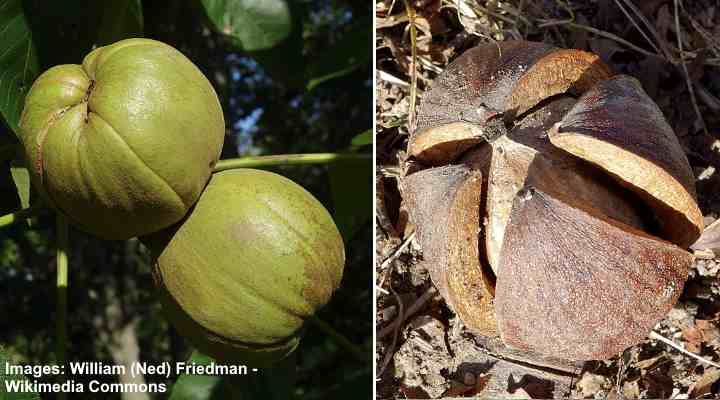
Carya laciniosa (shellbark hickory/kingnut hickory) immature fruit (left) and mature fruit (right)
Like most species of hickory, shellbark hickory has high-quality, strong lumber. The wood from shellbarks is used for tool handles, drumsticks, furniture, and sporting bats.
Shellbark hickory trees—like all hickory species—produce flowers. The male hickory trees produce catkins that are a yellow-green color. Female hickories produce small clusters of up to 10 flowers. However, the flowers on all species of hickory trees are insignificant.
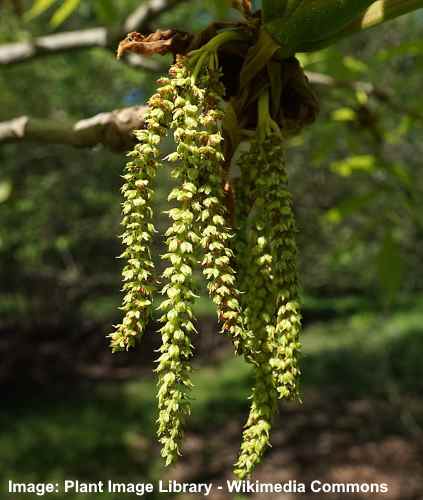
A close up picture of Carya laciniosa catkins of male flowers
Hickory nut: Shellbark hickory is also named kingnut hickory due to the large, sweet nuts the tree produces. The large 'king nuts' are up to 2.6" (4.5 cm) long and 1.5" (4 cm) wide.
Hickory tree bark: Shellbark hickory bark is gray and smooth when young and gradually develops shallow, thin fissures. Unlike the shagbark hickory, shellbark trunks have a smoother feel when they're mature. However, their bark can peel easily, and the plates only have slight curling.
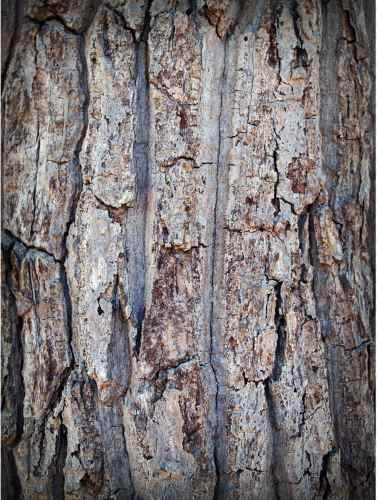
Carya laciniosa bark
Hickory tree leaves: Shellbark hickory leaves are pinnately compound leaves with between seven and nine leaflets. As with all hickories, the leaves are lanceolate shaped with serrated margins. In the fall, shellbark hickory foliage turns golden brown.
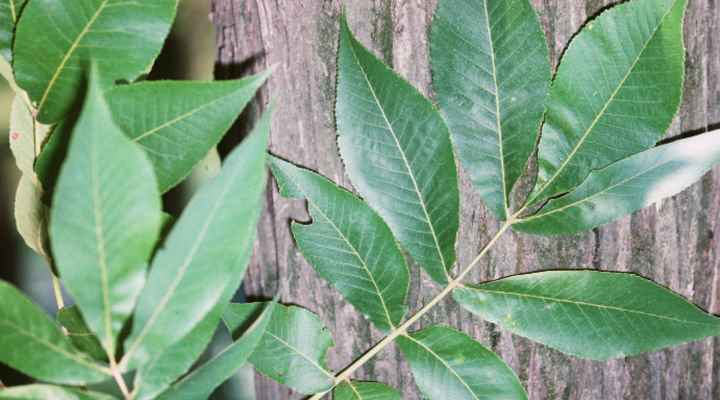
Carya laciniosa leaves
Shagbark Hickory (Carya ovata)
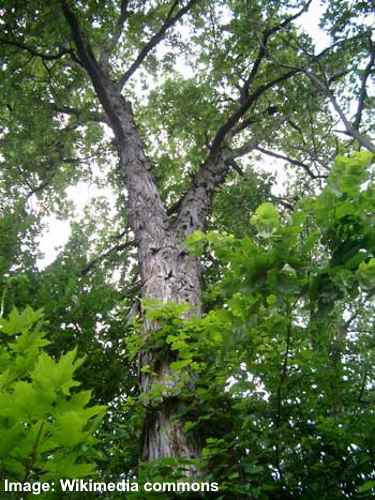
Shagbark hickory tree
Shagbark hickory trees have gray peeling bark giving the large slender trunk a disheveled look. Shagbarks can grow up to 120 ft. (36 m), but their average height is between 60 and 80 ft. (24 m). Shagbark leaves are deciduous and have five or seven rounded leaflets.
The two varieties of shagbark hickory are:
- Southern shagbark hickory (Carya ovata var. australis) – also called Carolina hickory. Some consider southern shagbark hickory as a separate species (Carya carolinae-septentrionalis).
- Northern shagbark hickory (Carya ovata var. ovata)
Shagbark trees have a substantial spreading canopy. The lush, green foliage is ideal as a shade tree in parks and streets.
Shagbark hickories are easy to distinguish from other species of hickory trees by their bark. Young hickories have smooth bark. With the shagbark species, the bark develops long, narrow plates that begin to curl away from the trunk. Mature shagbark trees have an unkempt, shaggy appearance.
Although shagbark hickories look like shellbark hickory trees, their shaggy appearance is their distinguishing feature.
Hickory nut: Shagbark hickory trees produce tasty edible nuts, which is one reason they're so popular. The delicious kernels are protected by an oval, hard, brown husk. Shagbark hickory nuts taste somewhere between walnuts and pecans and have a sweet buttery taste. Their flavor improves by roasting, drying, or toasting the nuts.
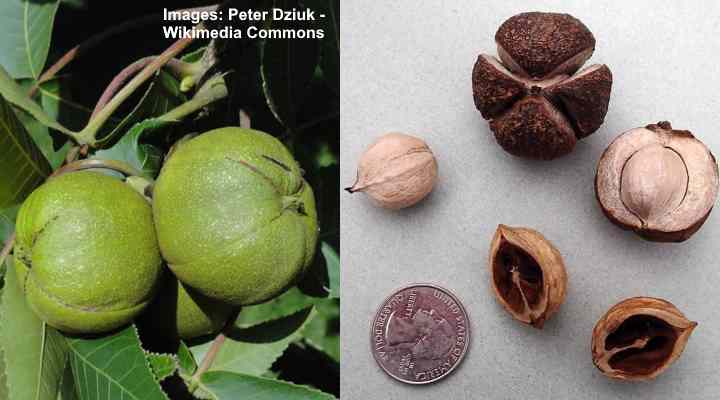
Shagbark hickory (Carya ovata) immature fruit (left) and mature fruit (right)
Hickory tree bark: Shagbark hickory bark is thick and scaly and exfoliates or peels naturally in thin strips. The shaggy curling bark on these hickories makes them highly ornamental trees.
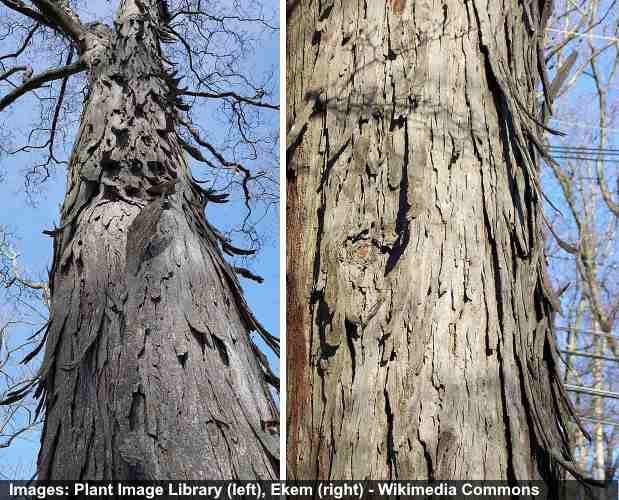
Carya ovata bark
Hickory tree leaves: Shagbark hickory tree leaves grow between 8″ and 14″ long with five or seven leaflets on a stem. The slightly rounded and pointed leaflets have toothed edges, giving them a jaggy appearance. Shagbark hickory leaves turn golden yellow in the fall.

Carya ovata leaves
Southern Shagbark Hickory (Carya carolinae septentrionalis)
The southern shagbark hickory has shaggy gray bark that peels away from the tree. The southern shagbark is like the shagbark hickory (Carya ovata) in appearance. The difference between the two species is that the southern shagbark has smaller nuts.
Also called the Carolina hickory, the southern shagbark grows to between 65 and 100 ft. (20 – 30 m) tall. The shaggy-looking tree has a tall, slender straight trunk with branching high up in the tree.
Hickory tree bark: Southern shagbark hickories have gray bark that peels away in plates.
Hickory tree leaves: Southern shagbark hickory trees have leaves up to 12" (30 cm) long. Each pinnate leaf has five obovate shaped leaflets with finely serrated edges.
Pignut or Black Hickory (Carya glabra)
Also called the black hickory or smoothbark hickory, pignut hickory tree grows to between 50 and 80 ft. (15 – 24 m) high. Pignut hickory tree has a straight trunk and massive rounded crown. The pignut hickory tree has gray scaly bark that doesn't peel from the trunk.
The pignut hickory grows in rich dry to moist soils on ridges and hillsides. Due to its attractive growth, pignuts are beautiful ornamental trees in woodlands and open landscapes.
Hickory nut: Pignut hickories grow pear-shaped nuts. However, the nuts have a bitter taste and are not popular with humans. The common name for this hickory tree comes from the fact that hogs and other animals enjoy eating them.
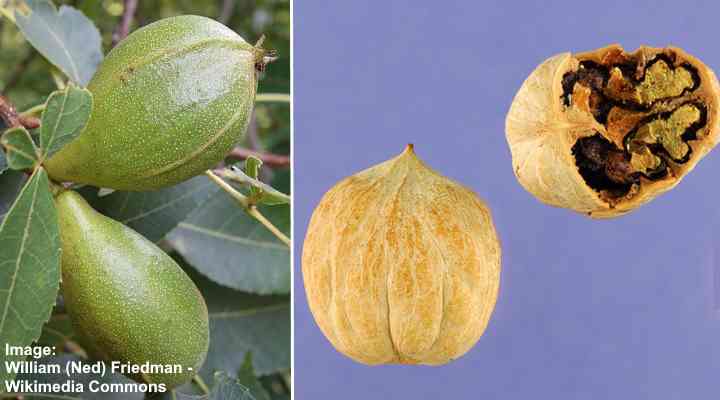
Pignut hickory (Carya glabra) immature fruit (left) and mature fruit (right)
Hickory tree bark: Pignut hickory trees have smooth gray bark when the tree is young. As pignuts mature, the bark develops scaly ridges and deep grooves. There is no bark peeling associated with these hickories.
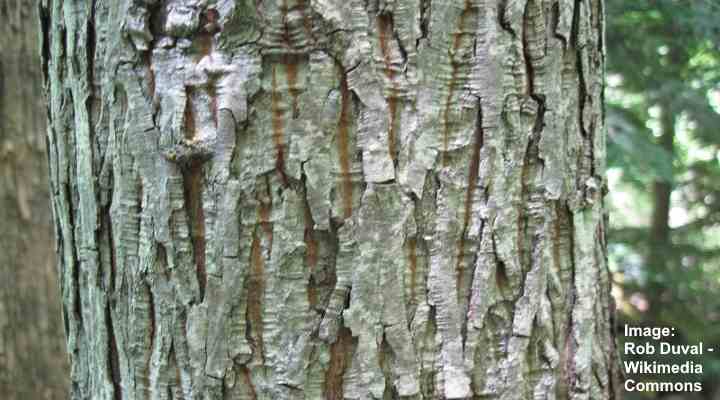
Pignut hickory bark
Hickory tree leaves: Pignut hickories have smooth lanceolate leaves with finely toothed margins. Five or seven blades make up each leaf, and they turn an attractive yellow in the fall.
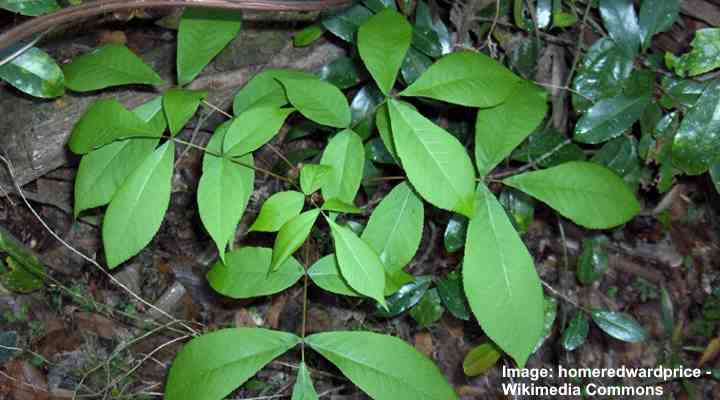
Pignut hickory leaves
Pecan (Carya illinoinensis)
Pecans are a hickory tree species with grayish-brown bark and thick narrow fissures. Pecan trees are enormous and can grow to between 66 and 130 ft. (20 – 40 m) tall. Their wide canopy of 75 ft. (23 m) provides plenty of shade underneath. Pecans are famed for their tasty nuts.
Pecan nuts or drupes are rich brown and grow in a thin husk that splits into four sections. The nuts are an oblong shape and have a distinctly buttery flavor with a waxy texture.

Carya illinoinensis immature fruit (left) and pecan nut (right)
Pecan tree bark: Pecan trees have reddish-brown or gray bark that has flat scales and deep fissures.
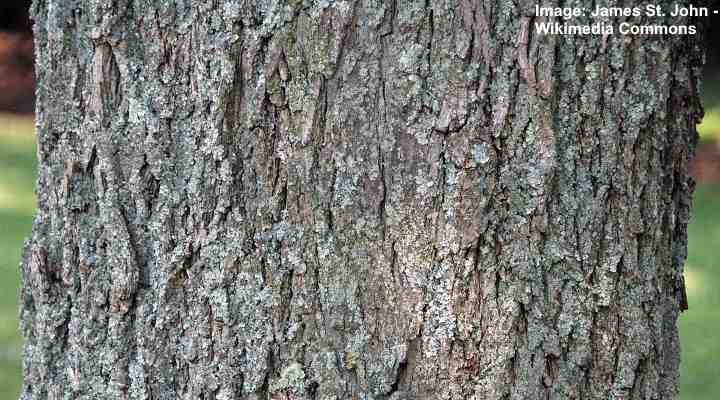
Carya illinoinensis bark
Pecan tree leaves: From all the hickories, pecan tree leaves are much more pointed. Usually, up to 15 leaflets on each leaf, giving pecan leaves a fern-like appearance.
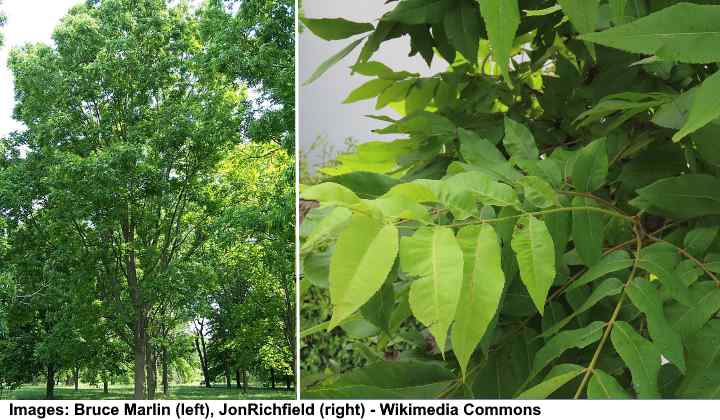
Carya illinoinensis tree on the left, and leaves on the right
Mockernut Hickory (Carya tomentosa)
Mockernut hickory trees have thin gray bark with deep narrow furrows. Mockernuts grow to between 60 and 80 ft. (18 – 24 m), have a rounded crown, and produce nuts that are difficult to crack. Mockernut trees have compound pinnate yellowish-green leaves. The mockernut is also called the white hickory.
Hickory tree bark: Mockernut hickory trees have gray bark, characterized by long vertical fissures close together. Some mature mockernut trees have bark that tends to peel.

Mockernut hickory bark
Hickory tree leaves: Mockernut hickory leaves have five ovate-lanceolate leaflets that have slight serration along the edges.
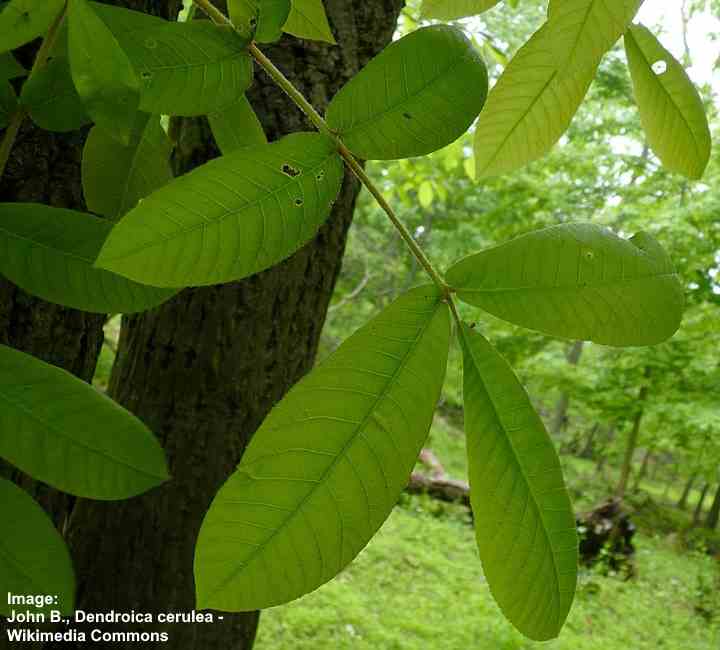
Mockernut hickory leaves
Bitternut Hickory (Carya cordiformis)
Bitternut hickory trees have large pinnate leaves, slender green twigs, and grayish bark with diamond pattern fissuring. Bitternut hickories grow up to 115 ft. (35 m) tall with an irregular oval crown.
Hickory nut: Bitternut hickories produce inedible, bitter-tasting nuts.
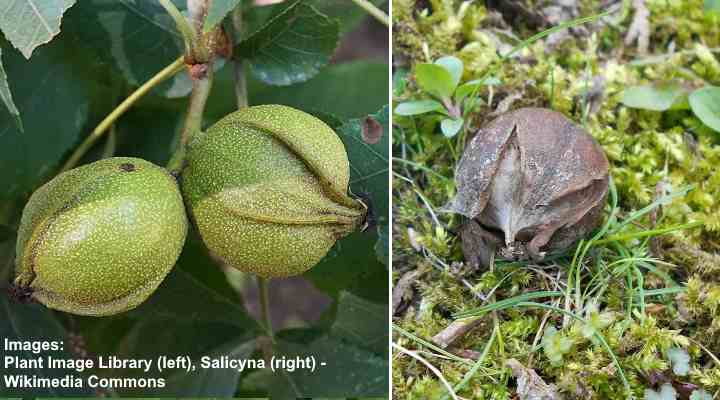
Bitternut hickory immature fruit (left) and nut (right)
Hickory tree bark: Bitternut hickory bark starts smooth and gray before becoming grayish-brown with ridges as the tree matures. Unlike other types of hickories, bitternut bark rarely peels.
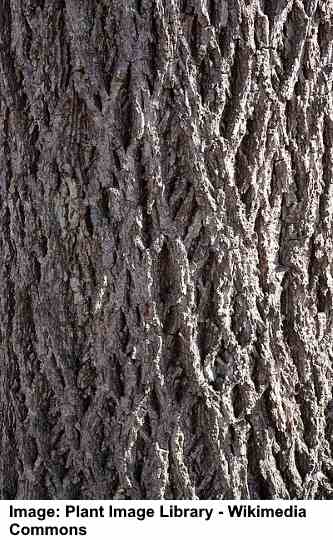
Bitternut hickory bark
Hickory tree leaves: Bitternut leaves are light green with five to nine broad leaflets on each leaf stem. These hickory tree leaves turn golden yellow in the fall.
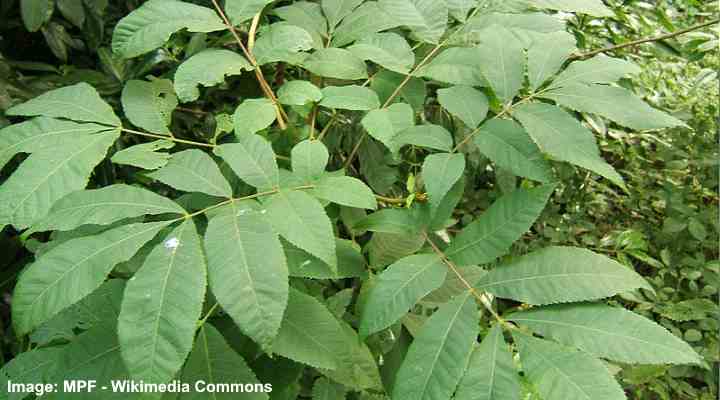
Bitternut hickory leaves
Red Hickory (Carya ovalis)
Red hickory trees have a single, straight trunk with gray bark and flaking plates. Red hickories grow on slopes and ridges in dry, sandy soil. The medium-sized to large shade trees can reach up to 100 ft. (30 m) high.
Hickory nut: Red hickories produce small oval nuts that vary in taste from bitter to sweet.
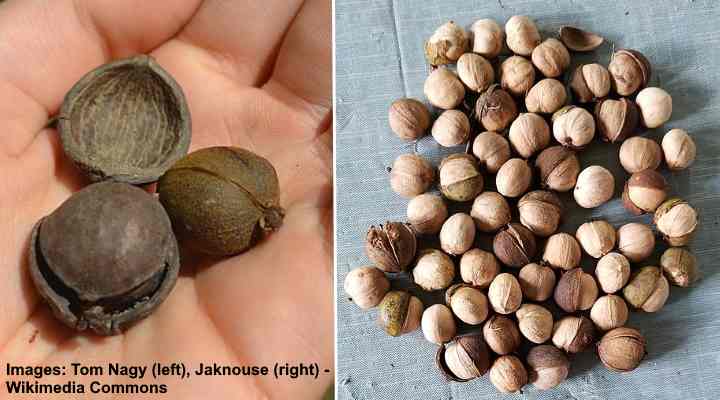
Red hickory nuts
Hickory tree bark: Red hickory trees have gray bark with flat ridges with a thin fissure separating them. Red hickories that grow fast tend to have bark that peels and curls outward on the trunk.
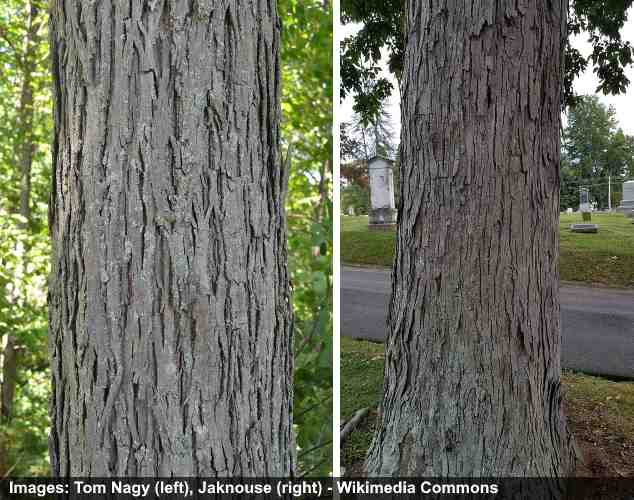
Red hickory bark
Hickory tree leaves: Red hickory leaves typically have seven smooth glossy leaflets, with finely serrated edges.
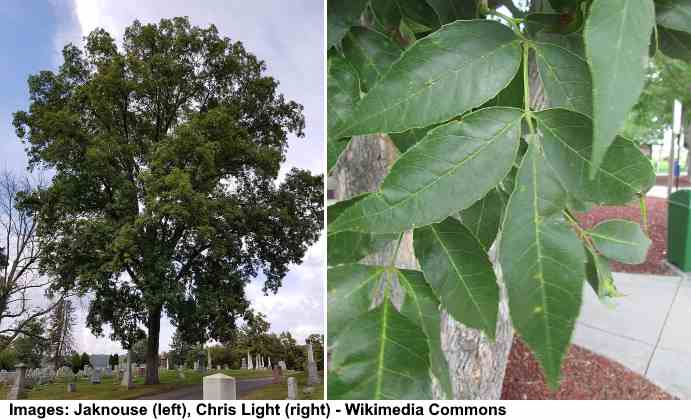
Red hickory tree and leaves
Sand Hickory (Carya pallida)
Sand hickory trees have smooth bark with shallow furrowing in a network-type pattern. Sand hickories are slow-growing deciduous trees, growing up to 80 ft. (24 m). The characteristics of sand hickory trees are shiny pinnate leaves with pointed leaflets and small edible drupes.
Scrub Hickory (Carya floridana)
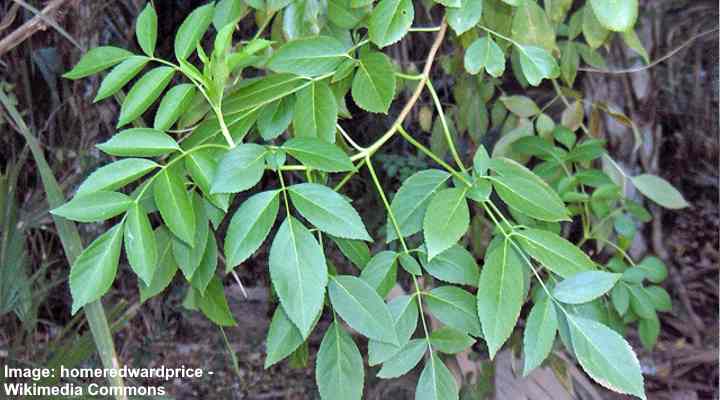
Scrub hickory leaves
Scrub hickories are tree-shrubs that may only reach 16 ft. (5 m) tall. However, some scrub hickory trees can grow up to 80 ft. (25 m) tall. These small hickory trees have 12″ (30 cm) leaves with seven broad pointed leaflets. Scrub hickories produce small edible drupes.
Scrub hickory got its botanical name Carya floridana as this tree is native to Southeast United States, and is endemic in central Florida.
Nutmeg Hickory (Carya myristiciformis)
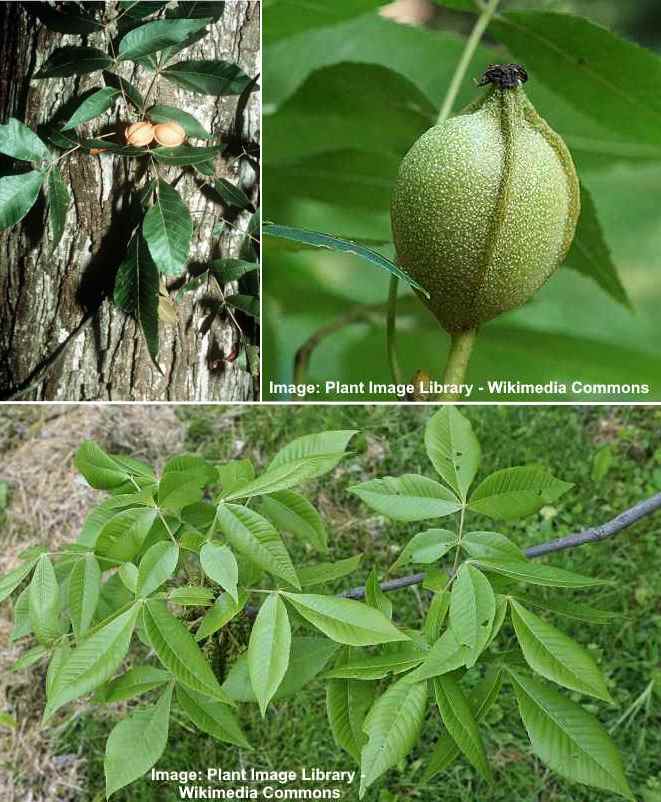
Images top left clockwise: nutmeg hickory bark and nuts, immature fruit and leaves
The nutmeg hickory tree has brownish-gray bark that tends to peel in plates. Nutmeg hickories are one of the rarest native hickory trees. These hickories have shiny green leaves with a silvery underside. The round nutshells are reddish-brown with patterns resembling nutmegs, and their kernels are sweet.
Nutmeg hickories grow up to 100 ft. (30 m) and are only found growing in scattered populations in some of the southern states.
Black Hickory (Carya texana)
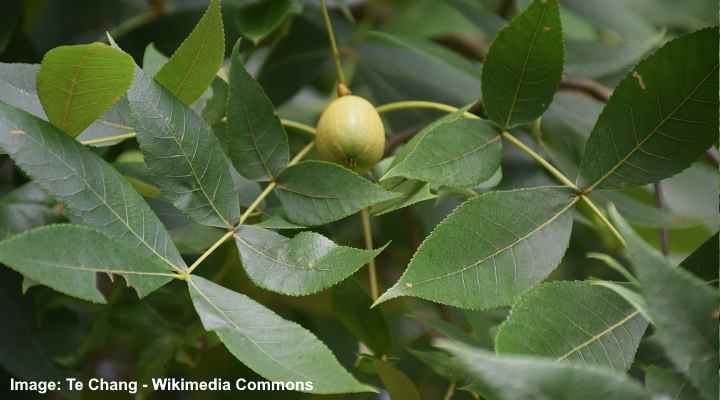
Black hickory (Carya texana) leaves
Black hickory trees have dark-colored bark with diamond-shaped ridges and a smoother look than shagbark hickories. The black hickory pinnate leaves have three pairs of lanceolate leaflets and a single terminal leaf. Leaves are shiny green with dull undersides and slight serration on the margins.
Black hickories are small, slow-growing trees that reach about 50 ft. (15 m) in height.
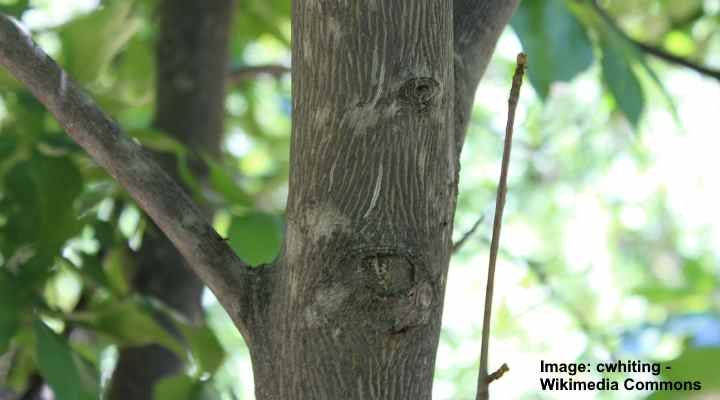
Carya texana bark
Learn how to identify hickory nuts and how to harvest them.
Related articles:
- Walnut Trees: Types, Bark and Leaves – Identification Guide
- Types of Elm Trees with Their Bark and Leaves – Identification Guide
- Types of Oak Trees with Their Bark and Leaves – Identification Guide
Read Next
Source: https://leafyplace.com/hickory-trees/
0 Response to "Drawing Shag Bark Hickory Tree"
Post a Comment